In this article, we continue our analysis of negotiable instruments with the bill of exchange. Historians believe the Bills of exchange to have been invented by Florentine Jews. They were created to avoid the transport of funds and have been used in trade since the middle ages. At the beginning they were used in foreign trade only. But with the time they were adopted in domestic trade too because they are practical and easy to use. Bills of exchange have been and remain the most often used forms of payments in local and international trade. In certain countries, businesses and individuals can draw a bill of exchange. In other countries, only businesses can issue a bill of exchange.
This article will address the following topics:
Contents of a Bill of exchange
Parties involved in a bill of exchange
Acceptance of a bill of exchange
Endorsement of a bill of exchange
Discounting of a bill of exchange
Factoring of a bill of exchange
Dishonour of a bill of exchange
What is a bill of exchange?
A bill of exchange is a written and unconditional order issued by the drawer (the seller of goods/services) and addressed to the drawee (the buyer) to pay a certain sum, either immediately (a sight bill) or on a fixed date (a term bill) to a specified person (usually the drawer himself) or to the bearer of the bill.
A bill of exchange can be payable to bearer or payable to order:
- Payable to bearer means payable to the holder or presenter. When a bill of exchange is payable to bearer, it means whoever holds the bill can receive the payment due on it.
- Payable to order (or payable to the order of) means the drawee is agreeing after signature that he will repay the money to the drawer or the person the drawer designates to receive the payments. With this mention, the drawer can later request the drawee to make the payment to another person / company that the drawer owes money to. A bill of exchange payable to order gives the drawer or bearer flexibility in designating who will receive the funds.
Unlike promissory notes, Bills of exchange are used almost exclusively in trade. If a bill is issued by a bank, it is referred to as a bank draft. If it is issued by an individual, it is usually referred to as trade draft.
Contents of a Bill of exchange
A bill of exchange complies with the Characteristics of Negotiable Instruments presented in a previous article. Issuer of a bill of exchange must stick to strict rules related to both form and substance of the document. In many countries, a bill of exchange document must contain some of the following elements (Read the commercial laws of your own country to find out which elements are mandatory):
- Drawer of the Bill of exchange: This is the individual or entity (company) that issues the bill and gives order to pay the sum of money. Name and address must be mentioned.
- Drawee / Payor of the Bill of exchange: This is the person upon whom the bill of exchange is drawn and who accepts and pays the bill. Name and address are generally requested.
- Payee of the Bill of exchange: This is the person to whom the payment is made. Name and address are generally requested. The Drawer and the Payee is usually the same person.
- Creation date and place of the Bill of exchange: The date and place where the Bill of exchange is created.
- Amount of the Bill of exchange: The sum of money that the payee will receive must be clearly featured on the document. The amount is usually given both in figures and words.
- Term of the bill of exchange: Also called tenure or maturity of the bill, it is the date on which the bill is to be paid. It should be specified in the body of the bill. In certain countries, a grace period of few days is given after the expiry of the term. If the exact due date is not explicitly indicated on the bill, information should be available allowing to calculate the term. If a bill of exchange is payable after two months, then it means 60 days after it was issued.
Note : A Bill of exchange may not contain a date at all. That is the case for bill of exchanges payable on demand (Mentions “At sight” or “On presentment” on the bill), or after presentment for sight (mention “After sight” on the bill).
- For Value Received: In certain countries, this aspect is crucial in the sense that law does not consider those agreements which have been made without consideration. Consideration refers to the context in which the bill of exchange was issued. It means the bill is drawn in exchange of some benefit that has already been received.
- Drawer’s signature: the drawer must to sign or stamp his signature after the drafting or drawing of the bill of exchange. A bill of exchange that does not have an authentic signature is considered null and is not eligible for the payment. The signature (handwritten or electronic) is the binding force of the bill of exchange.
A bill of exchange that is not correctly completed might cause problems. Among others, the delay of payment or the impossibility to discount. A correctly completed bill of exchange is essential and it is recommended to use forms that banks provide for that purpose.
Below is an example of a simple specimen of a bill of exchange.
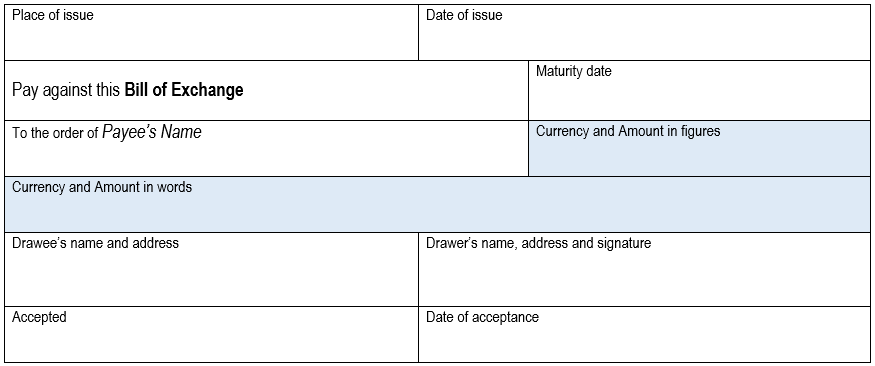
Additional elements might be added if relevant for the situation, but the drawer must ensure that all mandatory information is featured on the note.
Parties involved in a bill of exchange
Bills of exchange are negotiable instruments that involve three main parties: the drawer, the drawee and the payee. But depending on how it used, other parties listed below might be involved too (and the list is not exhaustive as we will see). In this paragraph, we will see when the different parties come in and which role they play.
- Drawer: the person who makes the bill and gives the order to pay a certain sum of money.
- Drawee: the person who is directed to pay a certain sum.
- Payee: The person receiving payment is called the payee. It is the drawer himself in the vast majority of the cases, but can be a designated person too.
- Acceptor: The person who accepts the bill. The drawee is normally the acceptor but a third person can accept a bill on behalf of the drawee.
- Bearer: the person who is in possession of a bill of exchange. He is also called the holder. The bearer and the payee is usually the same person.
- Endorser: the person who endorses a bill of exchange.
- Endorsee: the person in whose favor the bill of exchange is endorsed and who receives it after endorsement. He becomes the new bearer and payee after endorsement.
Now let us consider the different parties and when they step in from the time the bill of exchange is written and issued. We begin with the drawer, the drawee and the payee.
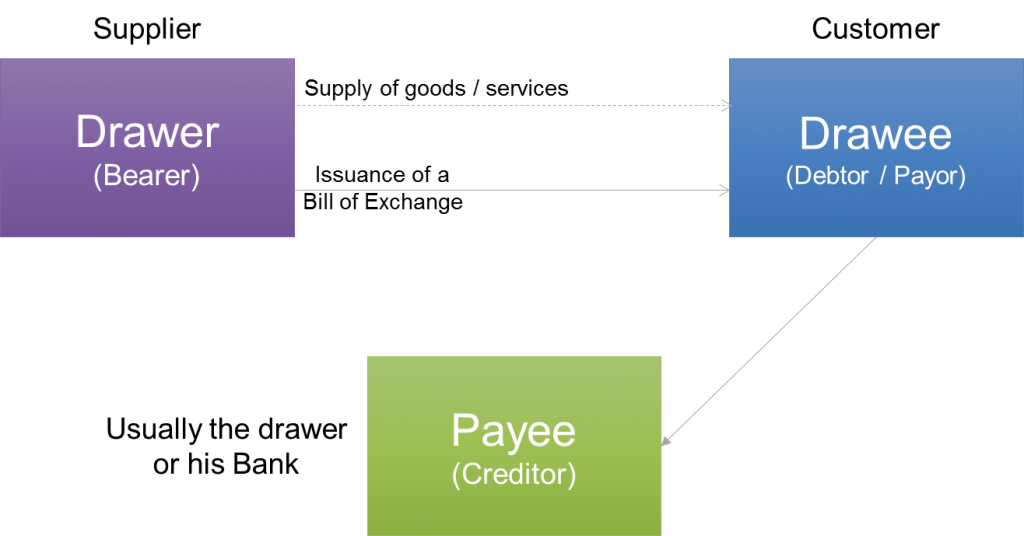
Drawer: It is the person who makes the bill and orders the drawee to pay a certain sum of money to the payee. The drawer generally issues the bill as part of a domestic or international commercial transaction to receive payment for value delivered.
Drawee: The drawee is the other main party involved in the bill of exchange. He is directed to pay for goods or services received from the drawer.
Payee: The creditor of the bill of exchange is called the payee. Since the drawer is the one who delivers value to the payee, he is also the one who is entitled to receive the money. This explains why the drawer and the payee are the same unless the drawer requests the payee to pay to another party.
The bill of exchange is therefore an order to pay and requires acceptance to be valid. By acceptance, the drawee engages himself to pay the amount from the bill of exchange to the person who will bear or hold it on the due term.
Acceptance of a bill of exchange
After drawing the bill of exchange, the first thing the drawer does, is to present it to the drawee for acceptance. Unless it is accepted, the bill is not valid.
The drawee (or someone representing him) accepts the drawer’s bill of exchange by writing a date and signing under the words ‘accepted’ on face of the bill. If the bill of exchange does not contain the phrase “accepted on”, the drawee can write it himself if necessary (For example for bills payable after certain events). The signature is enough for acceptance. If there is no acceptance date, the bill is supposed to have been accepted on the day of issue.
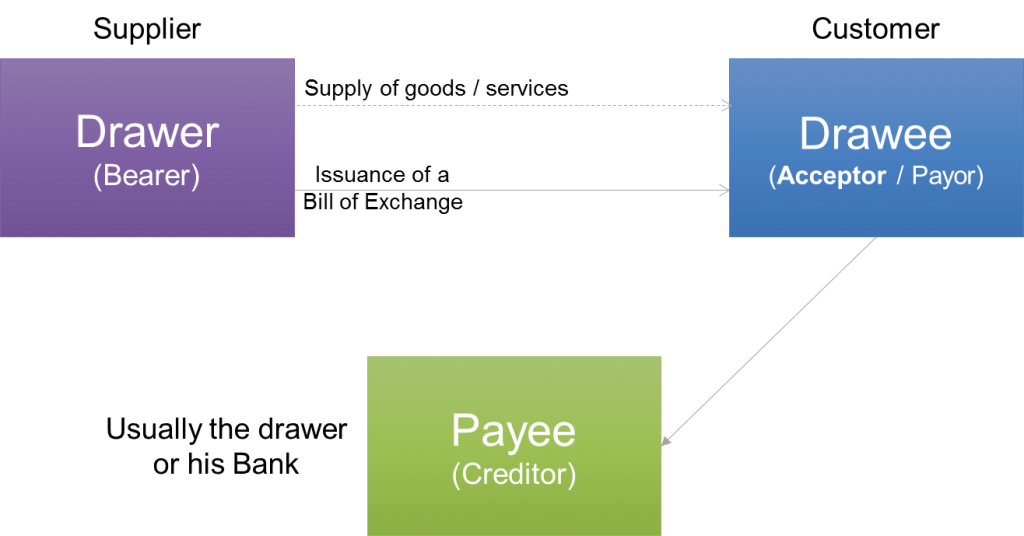
After acceptance, the drawee becomes the acceptor and engages himself to unconditionally pay the bill on or before its maturity date. The bill of exchange becomes a legal document only after acceptance. This document binds the drawee to honour the bill on due date. An acceptance is unconditional, but in certain countries the drawee may restrict it to part of the sum payable. The acceptance may be general or qualified:
- General Acceptance: This occurs when the drawee accepts the liability on the instrument without any condition and limitation on the amount. So general acceptance is unconditional and unqualified.
- Qualified Acceptance: When the acceptor puts some condition while accepting the instrument, the acceptance is said to be qualified. The acceptor can put only conditions that are legally allowed.
Once the bill of exchange is accepted, the drawee returns it to the drawer and bearer. And the bearer now has many options to choose between the following:
- Wait until maturity and present the bill of exchange for payment.
- Negotiate the bill of exchange to another person.
- Receive a short term finance by performing a discounting of the bill of exchange.
- Receive a short term finance by performing a factoring of the bill of exchange.
Endorsement of a bill of exchange
The second option consists for the drawer to endorse the bill of exchange and deliver it to another party. Endorsement requires to sign the bill and optionally to put words qualifying that act on it. The drawer, who then uses the bill as a financial instrument, becomes the endorser and the party receiving the bill is the endorsee, the new holder of the bill of exchange. He is also called the holder in due course. Below is a figure showing what happens. We assume in this and the following pictures that the drawer and the payee are the same.
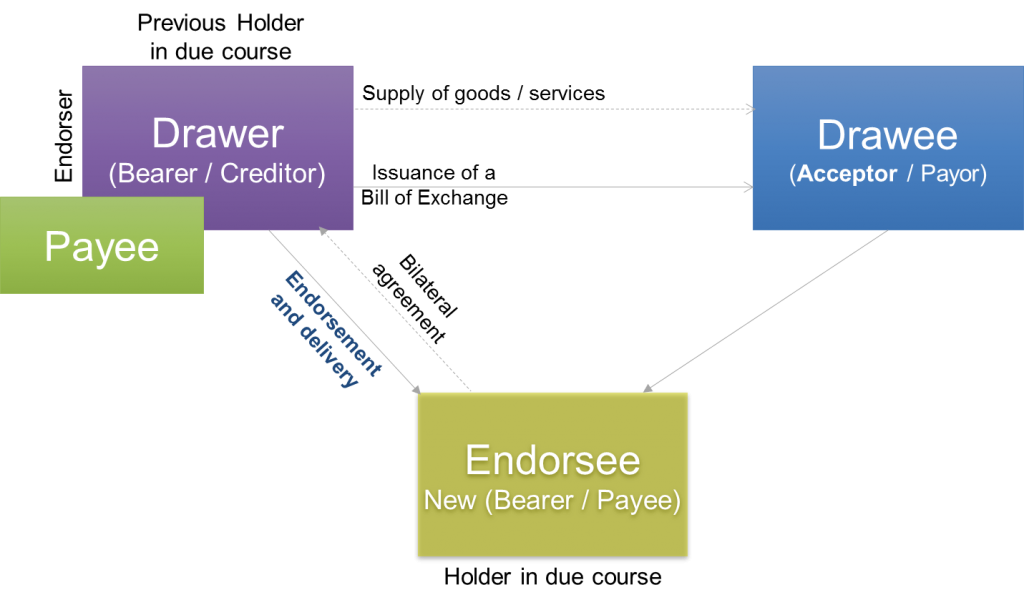
Why would the drawer (first holder) negotiate the bill of exchange to another party? There are several reasons. He may have a debt with that party that he wants to resolve. He may agree with the next party to negotiate the note in exchange of a sum of money. The negotiation is done to fix a financial problem. Otherwise, it is of no interest.
The negotiation process can happen as many time as needed. There is no limit to the number of endorsements that may be made on a bill of exchange. The endorser is not obliged to inform the initial drawer or any previous party that the bill has been negotiated. At maturity, the holder in due course presents the bill of exchange to the drawee for payment.
Remark: A bill that has not been accepted cannot be negotiated.
Discounting of a bill of exchange
As third option, the drawer or any subsequent endorsees can choose to discount the bill of exchange. Discounting is the arrangement in which a bank grants a short term credit on the basis of a bill of exchange to his holder, for less than the value shown on it before it is due to be paid. The holder, after providing evidence that he is in possession of a bill of exchange, receives the bill of exchange amount less administrative charges, fees and interest. The holder uses the bill in this context as a credit instrument.
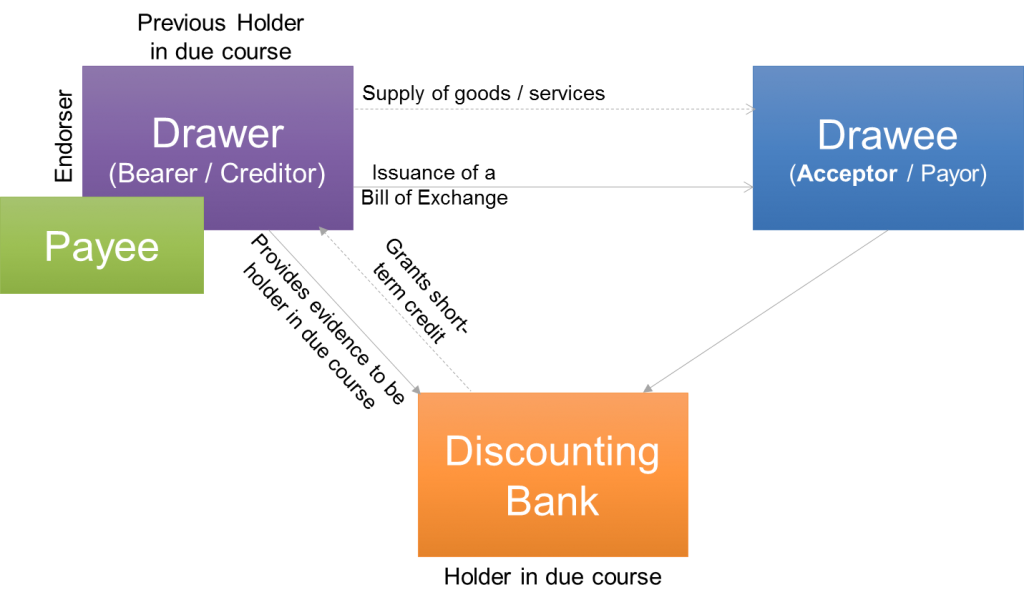
To compute the total fees, the bank takes into account the following elements: the amount and maturity date (due date) of the bill of exchange and the interest to apply. The longer the maturity, the higher the interest rate. The interest rate is referred to as the bank discount, or simply the discount rate. It usually includes the nominal interest rate and other charges. The period of discount is the period from the date of discount to the term or maturity date. The difference between the bill of exchange amount and all the charges, fees and interest is called the proceeds. The bank expects to receive the face value (total amount of the bill of exchange) as reimbursement amount at maturity date, generally in 30, 60 or 90 days. This explains why discounting is a short-term credit.
In general this is how Bank Discount and proceeds are computed:
- Bank Discount = Maturity Value x Discount Rate x Period of Discount
- Proceeds = Maturity Value – Bank Discount
The bank discount is what the bank earns in the process.
Note that unless agree otherwise with the discounting bank, the drawer (or any subsequent holder) remains responsible for collecting the bill of exchange amount after this arrangement. And in case the bill of exchange is dishonoured, the holder may get into big trouble, because he must pay back the credit to the bank anyway.
Factoring of a bill of exchange
The last option listed above is the factoring agreement. Factoring means an arrangement between a factor and his client where the factor buys a debt from its client. In Factoring, accounts receivable are highly discounted in order to allow the buyer, the factor, to make a profit when the debt is settled later. Discount rate are much higher in factoring than in normal discounting (explained in the paragraph above). Factoring transfers the ownership of accounts receivable to the factor that then chases up the debt.
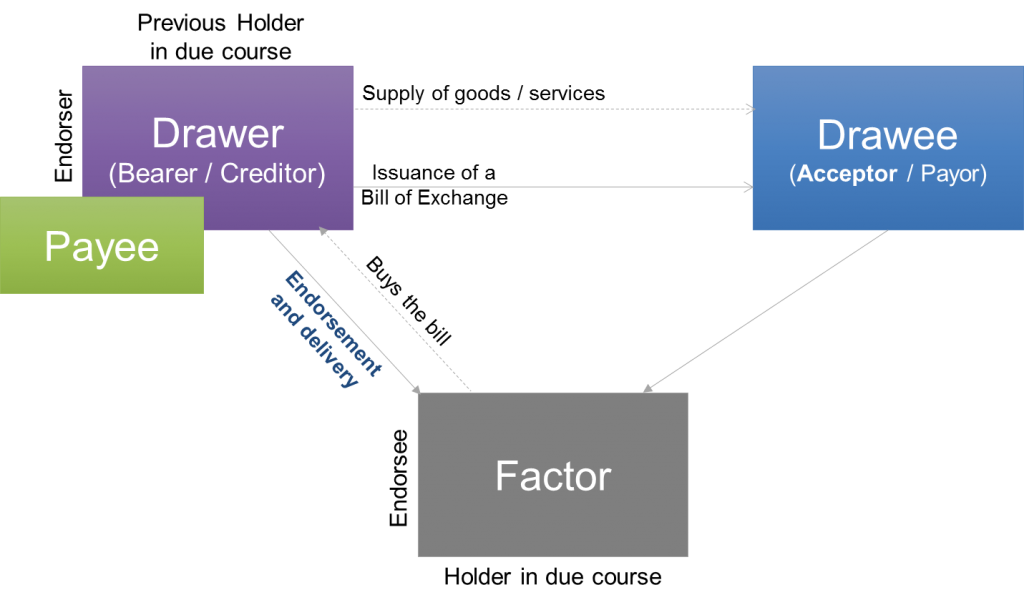
In factoring the drawer (or any subsequent holder) negotiates the bill of exchange to the factor. He is not responsible for collecting the bill of exchange amount anymore and therefore does not care that much if the bill of exchange is later dishonoured. The risk of non-payment (at maturity date) is completely transferred on the factor. That is why rates applied by factors are generally much higher than for those applied by discounting banks. And furthermore, the factor sometimes pays in two installments to limit own risks: one advance payment after the negotiation of the bill of exchange and a final payment when the face value is collected.
Dishonour of a bill of exchange
The bill of exchange, like any negotiable instruments, gives the holder a legal right of recourse against the endorsers and the drawer in case the bill is dishonoured. But the holder must undertake specific actions as we will see below.
[box type=”info” style=”rounded”]A bill of exchange can be violated by non-acceptance or by non-payment. A Promissory note can only be dishonoured by non-payment.[/box]
A bill of exchange is dishonoured by non-acceptance when the drawee refuses to accept and sign it. Unless there is something wrong with the content of the bill, acceptance is never a problem since the drawee does not have to pay immediately but only in one or many months. And even if the drawee has financial problems, he expects to fix them in the period between the acceptance date and the term. So he will sign the bill so that the other party does not become aware of his financial problems before the maturity of the bill.
If the bill is not accepted because the content is not right, the drawee will request the drawer to fix the content and then will sign the bill when he agrees with the content.
A bill presented for acceptance when the drawee has been declared insolvent will be refused since the drawer is anyway unable to pay because of insolvency. If the drawee is dead, he obviously cannot accept the bill of exchange.
A bill of exchange is dishonoured by non-payment when the drawee makes default in payment of the sum partially or totally.
When the bill is violated, the holder must give a sign or notice of dishonour to all the earlier parties to make them accountable. A notice of dishonor is simply a notice given by the holder of the bill of exchange to previous endorser(s) and to the drawee to inform them that bill has been dishonoured. Only after giving due notice of dishonour, the holder can sue the liable parties for the recovery of amount due on the instrument.
To provide a notice of dishonour, the holder takes the bill to a notary public who presents it again for acceptance or payment. In case the drawee refuses again, the notary public records the refusal on the bill. Thus ‘noting’ means recording the fact of dishonour on the dishonoured instrument or on a paper attached thereto for that purpose. It is recommended not to wait too long before doing noting. It should be done in the next 24 to 48 hours. Noting should specify the following on the instrument:
- Identification (Initials) of the notary
- A minute indicating that the instrument has been dishonoured and why; if the instrument has not been expressly dishonoured, the reason, why it is being treated as dishonoured
- The date of dishonour;
- The noting charges;
- The noting reference to the notary’s register.
In certain cases, noting may not be suitable to sue the previous endorser(s) and the drawee. The holder can then request the Notary public to draw a certificate of protest or certificate of dishonor.
When a bill gets dishonored and a formal certificate of dishonor is issued by the Notary Public, the bill can still be accepted for honour. The acceptor for honour is a person who voluntarily becomes a party to a bill as acceptor, in the event of the refusal by original drawee, and accepts to pay the bill if requested by the notary. The acceptor for honor offers to accepts the bill with a view to safeguard the honor of the original drawer or any subsequent endorser.
We analyzed the bill of exchange in this article and saw that many parties can be involved in the related processes. There are other important players that we did not mention at all: the drawer’s bank and the drawee’s bank. We will have a closer look at their roles in the next article: the four corner model for bills of exchange.






Liked this writeup. But one question, you say “A bill of exchange is dishonoured by non-acceptance when the drawee refuses to accept and sign it”. This statement is not making any sense to me. A bill of exchange is not a BoE at all when it is not signed and accepted by the drawee in the first place, and returned to the drawer. So where is the question of non-acceptance coming later? I have seen this every where written like this but not able to make a sense. Or is it that the BoE after acceptance by the drawee and returned to drawer and he further endorses it and say now it is in the 4th endorsee’s hands and he is the holder of the BoE now. Since maturity date is almost due, the 4th endorsee presents the BoE to the drawee for “acceptance again” indicating the payment has to be made to him? At this point the original drawee of the BoE again has to accept it. Please clarify kindlly?
Hi Surendran,
Thank you for your interesting question. I agree with your analysis. To be strict, “A Paper” really becomes a BoE after acceptance by the drawee. No need to accept a BoE twice. “Bills of Exchange” (the papers) are usually written on forms that are called “Bill of exchange forms” even though they are empty.
When the drawer fills it in, he is drawing “the bill”. In the article, you have this sentence: “After drawing the bill of exchange, the first thing the drawer does, is to present it to the drawee for acceptance. Unless it is accepted, the bill is not valid.” So I think many, and myself included, have “the paper” in mind when they say BoE. But again you are totally correct.
Regards, Jean Paul
Dear Sir
I have received a foreign BoE in which the Drawers bank name is not mentioned neither endorsed to the order of the drawers bank. Is it a discrepancy?
Thanking you in advance.
Hi Clint,
A bill of exchange must not mention the name of the banks. Payor and Payee must be clearly specified and it must be accepted. The article lists other mandatory elements.
Thanks for the clarification.
why is it important for a Notary to understand the concepts of an indorsement? Does it mattered?
why is it important for a Notary to understand the concepts of an indorsement?
I have a IBOE UNCITRAL for 20 Billion in EURO .. I need a BANK for Liquidity ?
My mail : marcosrobertodefreitas735@gmail.com
+55 44 9 99560428
The ALL CAPS NAME or “fictitious entity” indicated on the bill is the payee, as they are the ones recieving the value. The natural person who controls the all caps name is the creditor, the bank is the drawer. The only way to pay a bill is with interest…the interest that the bank owes to the creditor who must then reimburse himself by transferring the positive value of bearer securities to the principal (all caps name). All of your bills are already prepaid if your using income to pay bills you are uninformed.
Can you show an example endorsed bill of exchange on a bill form the water company?